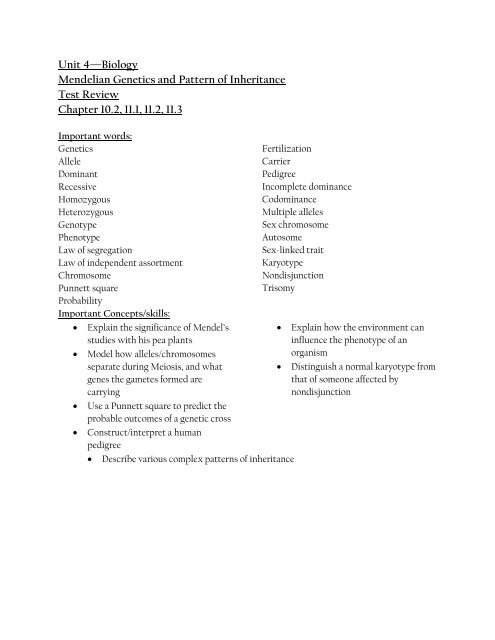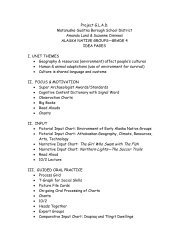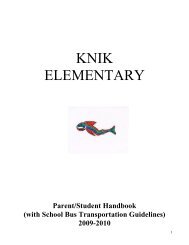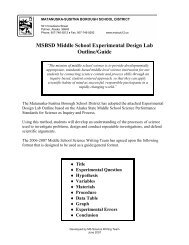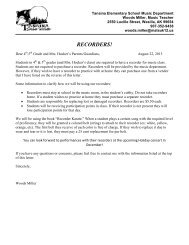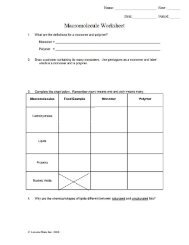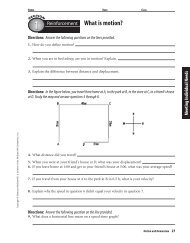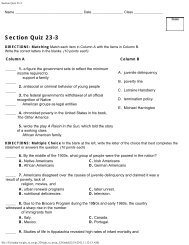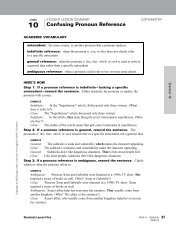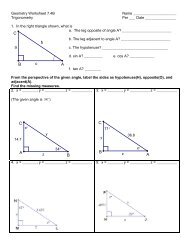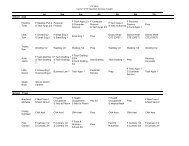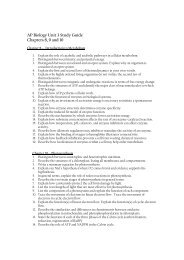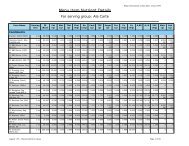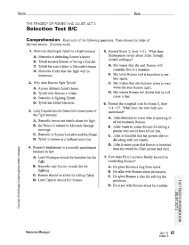Unit 4 Test Review
Unit 4 Test Review
Unit 4 Test Review
Create successful ePaper yourself
Turn your PDF publications into a flip-book with our unique Google optimized e-Paper software.
<strong>Unit</strong> 4—Biology<br />
Mendelian Genetics and Pattern of Inheritance<br />
<strong>Test</strong> <strong>Review</strong><br />
Chapter 10.2, 11.1, 11.2, 11.3<br />
Important words:<br />
Genetics<br />
Allele<br />
Dominant<br />
Recessive<br />
Homozygous<br />
Heterozygous<br />
Genotype<br />
Phenotype<br />
Law of segregation<br />
Law of independent assortment<br />
Chromosome<br />
Punnett square<br />
Probability<br />
Important Concepts/skills:<br />
Explain the significance of Mendel’s<br />
studies with his pea plants<br />
<br />
<br />
<br />
Model how alleles/chromosomes<br />
separate during Meiosis, and what<br />
genes the gametes formed are<br />
carrying<br />
Use a Punnett square to predict the<br />
probable outcomes of a genetic cross<br />
Construct/interpret a human<br />
pedigree<br />
<br />
Describe various complex patterns of inheritance<br />
Fertilization<br />
Carrier<br />
Pedigree<br />
Incomplete dominance<br />
Codominance<br />
Multiple alleles<br />
Sex chromosome<br />
Autosome<br />
Sex-linked trait<br />
Karyotype<br />
Nondisjunction<br />
Trisomy<br />
<br />
<br />
Explain how the environment can<br />
influence the phenotype of an<br />
organism<br />
Distinguish a normal karyotype from<br />
that of someone affected by<br />
nondisjunction
Sample Multiple Choice Problems—expect to see similar questions on the test!<br />
____<br />
1. A white mouse whose parents are both white produces only brown offspring when mated with a brown mouse. The white mouse is<br />
most probably ____.<br />
a. homozygous recessive c. homozygous dominant<br />
b. heterozygous d. haploid<br />
____<br />
2. In chickens, rose comb (R) is dominant to single comb (r). A homozygous rose-combed rooster is mated with a single-combed hen.<br />
All of the chicks in the F 1 generation were kept together as a group for several years. They were allowed to mate only within their own<br />
group. What is the expected phenotype of the F 2 chicks?<br />
a. 100% rose comb<br />
b. 75% rose comb and 25% single comb<br />
c. 100% single comb<br />
d. 50% rose comb and 50% single comb<br />
____ 3. In mink, brown fur color is dominant to silver-blue fur color. If a homozygous brown mink is mated with a silver-blue mink and 8<br />
offspring are produced, how many would be expected to be silver-blue?<br />
a. 0 c. 6<br />
b. 3 d. 8<br />
____<br />
4. The diagram in Figure 10-2 shows a diploid cell with two homologous pairs of chromosomes. Due to independent assortment, the<br />
possible allelic combinations that could be found in gametes produced by the meiotic division of this cell are ____.<br />
Figure 10-2<br />
a. Bb, Dd, BB, and DD c. BbDd and BDbd<br />
b. BD, bD, Bd, and bd d. Bd and bD only<br />
Figure 10-8<br />
____<br />
5. In Figure 10-8, which set of chromatids illustrates the result of a single crossover of the homologous chromosomes?<br />
a. A c. C<br />
b. B d. D<br />
____ 6. Which event during meiosis leads to a reduction in chromosome number from 2n to n?<br />
a. Pairs of homologous chromosomes line up at the equator.<br />
b. DNA undergoes replication.<br />
c. Homologous chromosomes travel to opposite sides of the cell.<br />
d. Sister chromatids are pulled apart at the centromere.
____<br />
7. Suppose an animal is heterozygous AaBb, and the traits are not linked. When meiosis occurs, what is the total number of possible<br />
combinations of gametes that can be made for these traits?<br />
a. 2 c. 6<br />
b. 4 d. 8<br />
Figure 11-1<br />
____<br />
8. Refer to Figure 11-1. If individual III-2 marries a person with the same genotype as individual I-1, what is the chance that one of their<br />
children will be afflicted with hemophilia?<br />
a. 0% c. 50%<br />
b. 25% d. 75%<br />
____<br />
9. What type of inheritance pattern does the trait represented by the shaded symbols in Figure 11-1 illustrate?<br />
a. incomplete dominance c. codominance<br />
b. multiple alleles d. sex-linked<br />
____<br />
10. For the trait being followed in the pedigree, individuals II-1 and II-4 in Figure 11-1 can be classified as ____.<br />
a. homozygous dominant c. homozygous recessive<br />
b. mutants d. carriers<br />
____<br />
11. A man heterozygous for blood type A marries a woman heterozygous for blood type B. The chance that their first child will have type<br />
O blood is ____.<br />
a. 0% c. 50%<br />
b. 25% d. 75%<br />
____ 12. What phenotype is depicted in Figure 11-5?<br />
Figure 11-5<br />
a. O c. A<br />
b. AB d. B<br />
____<br />
13. Nondisjunction is related to a number of serious human disorders. How does nondisjunction cause these disorders?<br />
a. alters the number of gametes produced<br />
b. alters the number of zygotes produced<br />
c. alters the chromosome structure<br />
d. alters the chromosome number
Answers<br />
1. A<br />
2. B<br />
3. A<br />
4. B<br />
5. A<br />
6. C<br />
7. B<br />
8. A<br />
9. D<br />
10. D<br />
11. B<br />
12. D<br />
13. D


